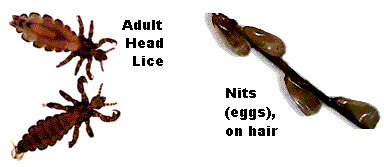-
Pediculosis (Head Lice)
Lice outbreaks are not uncommon among school children and the cleanest child can easily become infected. Do not panic if you find that your child has been infested with lice. Head lice do not spread disease. While time consuming in treatment, this is not a chronic health problem.
What To Look For
When there is intense itching and scratching of the scalp and the back of the neck, look closely at the scalp for small, white-ish eggs firmly attached to the hair shaft, especially at the nape of the neck and above the ears. Although these eggs may look like dandruff, dandruff can easily be removed from the hair while the eggs cannot.

What To Do
- Notify the school nurse if you confirm lice or eggs/nits.
- If members of your family become infested, you may treat them with an over-the-counter Pediculosis product from your drugstore, or you may contact your Health Care Provider for their recommendation. Remember to read directions thoroughly on any product used. Some products recommend another treatment in two weeks.
- After treatment, the nits or eggs should be removed from the hair. There is a comb included in most treatment packages, but often, the easiest method of removal is using your nails and pulling the egg off of the hair shaft. You should make sure you have plenty of light, positioning yourself by a window for ease of identification of the nit. The nits, as shown in the picture above, look like a small tear drops and are "cemented" on the hair shaft with the tip of the tear toward the scalp.
- If a child is suspected of having Pediculosis, the School Nurse will examine the suspected child and siblings. If head lice are found, the School Nurse will contact the parent of the child and provide educational materials concerning treatment and environmental control. Following treatment (this includes use of Pediculocidal agent and nit removal), the School Nurse will examine your child’s head. Proof of treatment (Pediculocidal agent or prescription packaging) must be provided to the School Nurse. Parents of the building will be notified via email of the lice identification. Neither class or grade level will be identified in the message.
- Wash all personal clothing (including jackets and backpacks) and bedding (sheets, blankets, pillowcases) in hot water (at least 130°F.) or by dry cleaning. Vacuum the mattress. We also recommend changing the pillowcase nightly for the following two weeks.
- Thoroughly wash combs and brushes in hot water to disinfect.
- Thoroughly vacuum furniture, rugs, and car interiors.
- Place all stuffed toys in a plastic bag for two weeks.
The District’s goals are for head lice to have minimal disruption to students’ educational experiences and minimize the stigmatizing impact on students and families.
Additional Information
- Head Lice 101 Fact Sheet - provided by the National Association of School Nurses and Sanofi Pastuer
- Head Lice Infestation (Pediculosis) - by Center for Disease Control (CDC)
- School Board Policy 209.1 - Pediculosis (Head Lice)
- Dr. Richard Pollack - Harvard School of Public Health - This site is provided by Dr. Pollack, a public health entomologist from the Harvard School of Public Health.
- American Academy of Pediatrics - Guidance on treating head lice
Select a School...
Select a School
- Bradford Woods Elementary School
- Franklin Elementary School
- Hosack Elementary School
- Ingomar Elementary School
- Marshall Elementary School
- McKnight Elementary School
- Peebles Elementary School
- Carson Middle School
- Ingomar Middle School
- Marshall Middle School
- NA Intermediate High School
- NA Senior High School
- NA Cyber Academy


